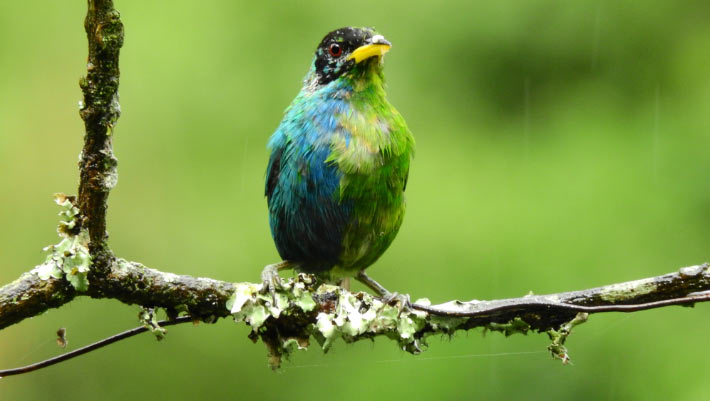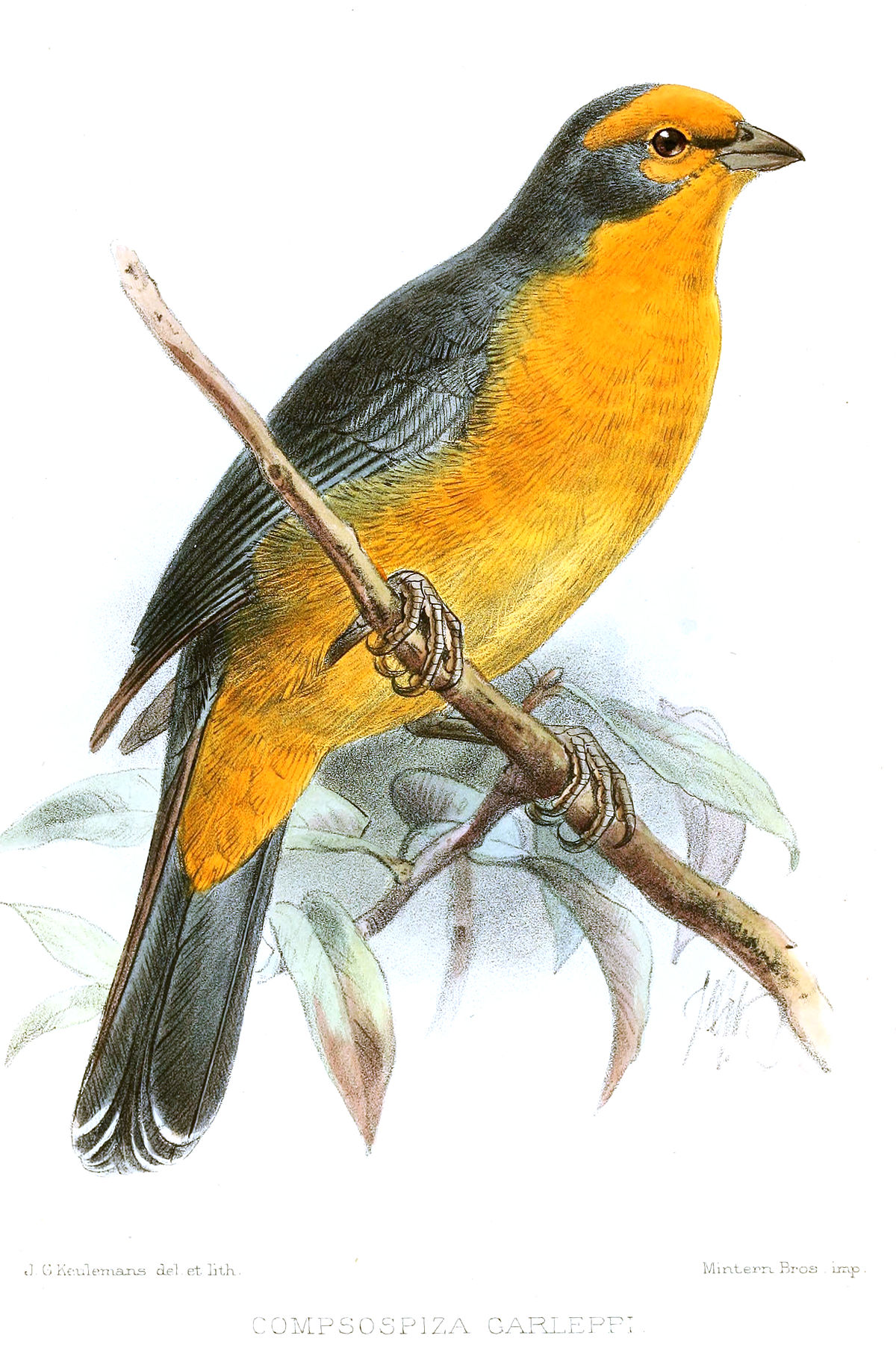Original text :
Apuntamientos para la historia natural de los páxaros del Paragüay y Rio de la Plata
NÚM. CXXXII.
DEL CHIPíU.
Es muy comun en todas partes, y el que mas se interna en los campos: tambien habita las quintas, y aun los pueblos en invierno, viviendo en sociedades, á veces tan numerosas, que casi se tocan los individuos quando se posan sin ocultarse en los árboles y matorrales; de modo que Noseda mató quarenta de un tiro. Su voz apelativa dice
chipíu, y le dan este nombre por excelencia. Vive en jaula con maiz quebrado y qualquiera semilla, aunque le cojan adulto; y canta bien. Vuela con violencia y á veces con bastante elevacion.
Longitud 5 pulgadas: cola 2: braza 8½. Toda la garganta, y hasta la cola, con las tapadas, son de un amarillo fuerte, no tan vivo en éstas, y algo opaco en los costados; pero hácia lo baxo de la garganta hace la opacidad una especie de gola, que no cierra. Ademas en el vientre se advierte una manchita blanca. De allí atras lo amarillo es mas caido: terminan los timoneles con las puntas blancas; y el costado externo de las piernas es pardo amarillazo. De la nariz principia una tirita amarilla, que pasa por la ceja y va pardeando en razon que va para atras. Sobre la cabeza desde el pico hay plumas que tienen los centros obscuros y las bordas amarillas ; pero este color va degenerando en pardo: de modo que el cogote y pestorejo son ya de un pardo aplomado en que apénas se percibe la obscuridad de los centros. Esto mismo sucede al costado de la cabeza; pero el pido es pardo, y baxo del ojo hay una manchita amarilla blanquizca. El lomo y rabadilla son de un amarillo pardo: las cobijas menores obscuras muy ribeteadas de amarillo; y la espalda, cola, sus timoneles superiores y los tres mayores órdenes de cobijas en los trozos internos, tienen las plumas pardas obscuras con las bordas blanquizcas. Las cobijas del trozo externo y todos los remos obscuros, con sutiles ribetes amarillos en los trozos externos, y blanquecinos en el interior.
La hembra es poquito menor, y se diferencia en que todo lo inferior es blanquizco, con el pecho y bordas de las tapadas color de caña, y baxo de la cabeza y timoneles inferiores blancos. Ademas la manchita que sale de la nariz es blanquizca parda, como todas las bordas en la cabeza y cobijas: las de los remos del trozo medio son amarillentas, el lomo y rabadilla par dos poco amarillazos, y el resto, como el macho.
Remos 18, fuertes y tendidos, el primero y segundo mayores: cola 12 plumas en escalerilla, la interna 3 lineas mas breve, todas angostas agudas y fuertes: pierna 12½; tarso 8½, trigueñas: dedo medio 6½: pico 4½, alto y ancho 3, obscuro arriba, blanquizco abaxo.
**********************
Azara's descriptions are always quite technical (and his Spanish may be a bit dated ?) -- I always struggle a bit to translate them. Thus if anything below is a bit off, feel free to correct it. Anyway, more or less :
NO. CXXXII.
OF THE CHIPÍU.
It is very common everywhere, and the one that penetrates most into the fields: it also inhabits the country houses, and even the towns in winter, living in societies, sometimes so numerous, that the individuals almost touch each other when they land without hiding in the trees and bushes; so that Noseda killed forty in one shot. Its calling voice says
chipíu, and gives it this name par excellence. It lives in cage on broken corn and any seeds, even if caught as an adult; and sings well. It flies violently and sometimes quite high.
Length 5 inches: tail 2: span 8½. The entire throat, and down to the tail, including the underwing, are a strong yellow, not so bright in the latter, and somewhat dull on the flanks; but towards the lower throat the dullness forms a kind of collar, which does not close. Also, on the belly, there is a small white spot. From there behind the yellow is weaker: the feathers end with white tips; and the outer side of the thighs is yellowish brown. A yellow stripe starts from the nostril, which passes through the brow and turns brown as it goes backwards. On the cap from the beak, there are feathers that have dark centres and yellow edges; but this color turns into brown: so that the nape and neck are already a leaden brown in which the darkness of the centres can barely be perceived. This same thing happens on the side of the head; but the ear is brown, and under the eye there is a small whitish yellow spot. The mantle and rump are brownish yellow: the smaller coverts are dark, strongly edged with yellow; and the back, tail, its upper coverts and the three large rows of coverts in the inner wing, have the feathers dark brown with whitish edges. The coverts on the outer wing and all the remiges are dark, with the edges subtly yellow on the outside, and whitish on the inside.
The female is slightly smaller, and she differs in that the entire underparts are whitish, with the chest and border of the underwing cane-coloured, and the lower head and lower feathers white. Furthermore, the small spot that starts from the nostril is whitish-brown, like all the fringes on the head and covers: those on the middle remiges are yellowish, the back and rump are slightly yellowish, and the rest, like the male.
18 remiges, strong and straight, the first and second longest: tail with 12 feathers in a ladder, the inner one 3 lines shorter, all narrow sharp and strong: leg 12½; tarsus 8½, dark: middle finger 6½: bill 4½, height and width 3, dark above, whitish below.
********************
For me clearly some kind of
Sicalis (or something similar, but then I cannot really figure what -- yellow and brownish males, duller females, forming large mobile flocks in the countryside). I just cannot turn that into any warbling-finch.
XC31723 Grassland Yellow Finch (Sicalis luteola) ?


 journal.afonet.org
journal.afonet.org









